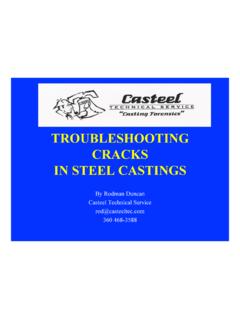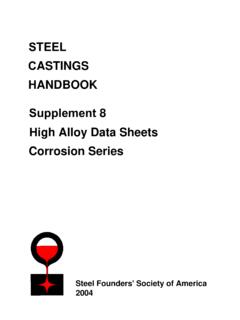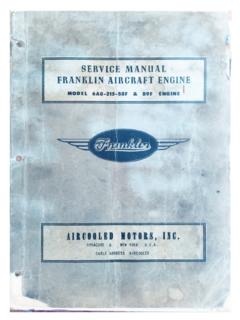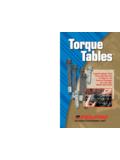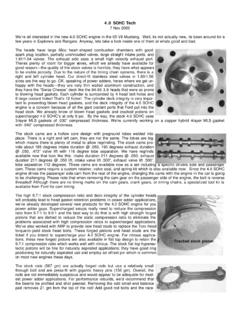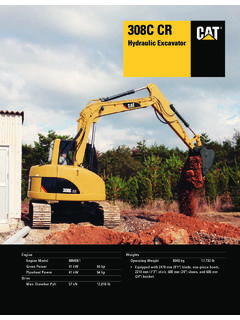Transcription of Aluminum Cylinder Block for General Motors …
1 A Design Study in Aluminum CastingAluminum Cylinder Block for General Motors Truck/SUV EnginesChevy TrailblazerDesign Study Outline-- Introduction-- Designing for Performance Alloy Selection -- Lost Foam Casting Pattern Design Pattern Production Metal Casting-- Finishing and Quality Assurance -- Lessons Learned and Summary Start the Design Study !NextAcknowledgment --The metalcasting design studies are a joint effort of the American Foundry Society and the Steel Founders' Society of America. Project funding was provided by the American Metalcasting Consortium Project, which is sponsored by the Defense Logistics Agency, Attn: DLSC-T, Ft.
2 Belvoir, VA, 22060-6221 Return to AFSHome PageCopyright 2004 by the American Foundry SocietyAll rights reserved. Address comments to: Modified:August, 2004 by STGIn cooperation withGM Powertrain Casting Development A Design Study in Aluminum Castings - GM Cylinder Block Engines for GM SUVs and Trucks The Application -- In 2002 General Motors introduced a new family of Sport Utility Vehicles (Chevy Trailblazer, Buick Rainier and GMC Envoy). In 2004 a family of mid-sized trucks (Chevy Colorado and GMC Canyon) was With the higher vehicle weight and additional load capability, the engineering challenge was to upgrade the powertrain with improvements in power, torque, fuel economy, emissions, and NVH (noise, vibration, harshness ) performance, while keeping the vehicle cost affordable and the weight down.
3 L A comprehensive engineering study was done to select the best engine configuration, considering V-8, V-6, and Inline 6 designs. The study determined that the Inline design had the following advantages -- simplest design, lowest number of parts, inherently balanced, lowest cost, and best manufacturing The Inline 6 was designed to have the power and torque of a V-8. The inline 5 was designed to match the performance of a V-6. Both engines provide improved fuel economy without sacrificing performanceInline 5 Cylinder liter EngineGMC CanyonBackNext2 Return to AFSHome PageCopyright 2004 by the American Foundry Society All rights reserved.
4 Address comments to: Modified:August, 2004 by STGPage 1In cooperation withGM Powertrain Casting Development A Design Study in Aluminum Castings - GM Cylinder Block Engine DesignThe inline design is applicable to 6, 5, and 4 Cylinder ( , and Liter displacement) engine configurations. l The SUVs come equipped with the six Cylinder version and the mid-size trucks are equipped with the four or five Cylinder versions of the engine family. l All three inline engines use the Vortec Cylinder design and have a 93mm bore x 102mm stroke with a double overhead cam using 4 valves per Cylinder .
5 L The engines operate with a 10:1 compression ratio, but still use regular unleaded fuel (87 RON). l The three inline engines have 75% part commonality. GM Vortec Inline EngineBackNext3 Return to AFSHome PageCopyright 2004 by the American Foundry Society All rights reserved. Address comments to: Modified:August, 2004 by STGPage 1In cooperation withGM Powertrain Casting Development A Design Study in Aluminum Castings - GM Cylinder Block Engine SpecificationsThe performance specifications for the three engines are -- Cylinder Count &Displacement6 Cylinder Liter5 Cylinder Liter4 Cylinder LiterPeak Horsepower275 HP @ 6000 RPM215 HP @ 5600 RPM170 HP @ 5600 RPMPeak Torque275 FT-LB @ 3600 RPM225 FT-LB @ 2800 RPM175 FT-LB @ 2800 RPMBase Engine Weight184kg178 kg150 kgThe newly designed inline engines are significantly lower in weight than previous truck engines with the same
6 Performance Return to AFSHome PageCopyright 2004 by the American Foundry Society All rights reserved. Address comments to: Modified:August, 2004 by STGPage 1In cooperation withGM Powertrain Casting Development A Design Study in Aluminum Castings - GM Cylinder Block Aluminum Castings for the EngineOne of the key weight saving features in the engine design is the use of a cast Aluminum Cylinder Block with cast iron Cylinder liners. l The cast iron liners (with ground outside-diameter) are press-fit into the precision bored Aluminum Cylinder Block . This provides optimal heat transfer into the Cylinder Block .
7 M The iron liners provide the wear resistance needed for improved The installation process for the liners includes chilling the liner prior to placement and sophisticated precision force monitoring to ensure proper installation. l After installation, the ID of the iron liner is bored to a mass-saving millimeter wall Return to AFSHome PageCopyright 2004 by the American Foundry Society All rights reserved. Address comments to: Modified:August, 2004 by STGPage 1In cooperation withGM Powertrain Casting Development A Design Study in Aluminum Castings - GM Cylinder Block Cylinder Block DescriptionAs an example, the Cylinder Block for the inline 5 Cylinder engine is 24" x 17" x 13" (61 cm x 43 cm x 33 cm) in Block dimensions and has a cast weight of 86 pounds.
8 L The Cylinder Block casting incorporates many unique cast-in internal features which reduce machining costs, including: high pressure oil passages, oil drain-backs, the crankcase air passages, and coolant jackets and channels. l On the exterior of the Block there are numerous ribs, pads, channels, and holes for strengthening, weight reduction, and accessory attachment. BackNext6 Return to AFSHome PageCopyright 2004 by the American Foundry Society All rights reserved. Address comments to: Modified:August, 2004 by STGPage 1In cooperation withGM Powertrain Casting Development A Design Study in Aluminum Castings - GM Cylinder Block Cylinder Block Performance The Cylinder Block has to withstand high cycle fatigue stresses, thermal strains, and aggressive wear conditions over the full life of the engine.
9 The typical performance requirements for the Cylinder Block cast in lost foam with Aluminum are --l Ultimate Tensile Strength = 35 ksi / 245 MPa l Yield Stress = 31 ksi / 215 MPal Elongation = Brinell Hardness = 80 BHNl Fatigue Strength ( 10^8 cycles) = ksi / 60 MPal Pressure tightness = Excellentl Machinability = GoodPower Train with Engine and TransmissionBackNext7 Return to AFSHome PageCopyright 2004 by the American Foundry Society All rights reserved. Address comments to: Modified:August, 2004 by STGPage 1In cooperation withGM Powertrain Casting Development A Design Study in Aluminum Castings - GM Cylinder Block Lost Foam CastingAll of the Aluminum blocks and heads in this family of engines are produced by using the "lost foam casting" processThe lost foam casting process uses a expanded polystyrene replica of the part being cast.
10 L The coated replica/pattern is placed in a flask and loose sand is placed around the pattern and shaken into its voids. l Molten Aluminum is then poured through a foam sprue, or funnel, into the sand where the hot metal melts and displaces the foam of the pattern. l The metal cools in the shape of the part. Unlike conventional sand casting, the lost foam process allows more complex and detailed passages and other features to be cast directly into the part. The lost foam process:l Forms complex internal passages and features without Reduces part mass with near net shape Eliminates parting Reduces machining operations and Provides for tight tolerances in critical areas and Return to AFSHome PageCopyright 2004 by the American Foundry Society All rights reserved.


